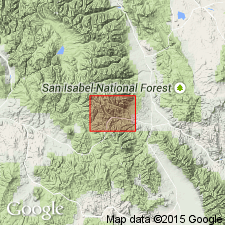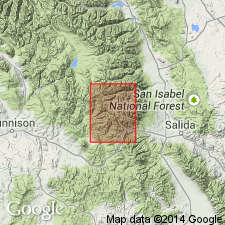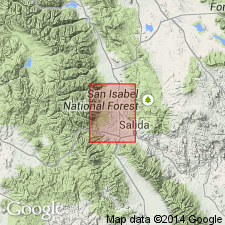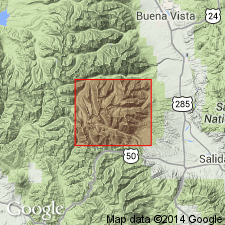
- Usage in publication:
-
- Etna quartz monzonite porphyry
- Modifications:
-
- Named
- Dominant lithology:
-
- Porphyry
- AAPG geologic province:
-
- Eagle basin
- Piceance basin
Summary:
Named for occurrence of quartz monzonite porphyry on top and slopes of Mount Etna, Chaffee Co, CO in the Eagle basin. Extends west into Gunnison Co, CO in the Piceance basin. Occurs in two stocks--one is 2 mi in diameter at Mt. Etna and the other is smaller north of Tomichi and as dikes--the longest extends from Clover Mountain to Browns Gulch. The same dike varies from 14 to 600 ft wide. No type locality designated. Characterized by numerous large pink to brown orthoclase phenocrysts one-half inch to 2 in long. Also has white to blue plagioclase, quartz, hornblende, and biotite. Chemical analyses. Is younger than Princeton quartz monzonite (new) and the quartz latite porphyry. Shown on geologic map as post-Carboniferous, probably Tertiary age.
Source: GNU records (USGS DDS-6; Denver GNULEX).

- Usage in publication:
-
- Mount Aetna quartz monzonite porphyry*
- Modifications:
-
- Named
- Dominant lithology:
-
- Porphyry
- AAPG geologic province:
-
- Eagle basin
Summary:
Named for Mount Aetna, its type locality, 3 mi north of Monarch, Chaffee Co, CO in the Eagle basin. Occurs as a stock near Mount Aetna. A smaller stock probably connected with the larger mass centers around Deer Gulch west of Vulcan Mountain. A smaller stock cuts valley of Bonanza Creek. Some occurrences are dikes. Is the coarsest grained porphyry in Garfield quad and is easily distinguished. Is light-, medium-, or pinkish-gray. Has large pink and white conspicuous feldspar phenocrysts. Most abundant phenocrysts are pink or gray orthoclase. Is younger than an unnamed quartz latite porphyry, and is older than volcanic breccia. Assigned to the Paleocene?, Eocene?, and Oligocene?.
Source: GNU records (USGS DDS-6; Denver GNULEX).

- Usage in publication:
-
- Mount Aetna Quartz Monzonite Porphyry*
- Modifications:
-
- Age modified
- AAPG geologic province:
-
- Eagle basin
Summary:
Age changed from Paleocene? to Oligocene? to Oligocene. Mount Aetna of the Eagle basin shown as younger than Wall Mountain Tuff.
Source: GNU records (USGS DDS-6; Denver GNULEX).

- Usage in publication:
-
- Mount Aetna Quartz Monzonite Porphyry*
- Modifications:
-
- Revised
- Geochronologic dating
- Overview
- AAPG geologic province:
-
- Eagle basin
- Piceance basin
Summary:
Occurs in Gunnison Co, CO, Piceance basin, and Chaffee Co, CO, Eagle basin, as an irregular stock and two major dikes that trend northeast-southwest and north-south from southeast and west sides of stock cutting Sewanee Peak Volcanics (new) and older rocks. Is mineralogically nearly identical to Mount Princeton Quartz Monzonite, but texturally distinct from all other rocks in area. Is distinctly coarsely porphyritic with large feldspar and quartz phenocrysts in a granitic matrix. Can be variable in phenocryst and groundmass abundance, and grain size. Rock is gray and punctuated with 0.5 cm long white plagioclase phenocrysts, rounded pink quartz up to 0.5 cm long and euhedral feldspar phenocrysts that average 1 cm long. Ages of 37.2 +/-1.7 m.y. (hornblende) and 36.0 +/-1.1 m.y. (biotite) K-Ar and 36.1 +/-0.3 m.y. (hornblende) and 34.0 +/-0.3 m.y. 39Ar/40Ar obtained. Oligocene age. Geologic maps
Source: GNU records (USGS DDS-6; Denver GNULEX).
For more information, please contact Nancy Stamm, Geologic Names Committee Secretary.
Asterisk (*) indicates published by U.S. Geological Survey authors.
"No current usage" (†) implies that a name has been abandoned or has fallen into disuse. Former usage and, if known, replacement name given in parentheses ( ).
Slash (/) indicates name conflicts with nomenclatural guidelines (CSN, 1933; ACSN, 1961, 1970; NACSN, 1983, 2005, 2021). May be explained within brackets ([ ]).

